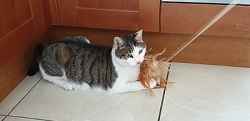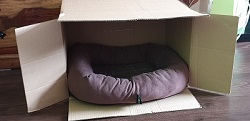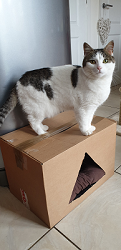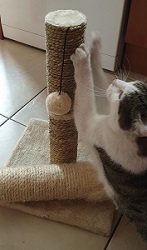Cats Indoors - Coronavirus
If you’ve been diagnosed with, or are suspected of having, symptoms of coronavirus (COVID-19) it is advisable to minimise the amount of unsupervised time your cat spends outdoors. Where possible, keep your cat indoors but make sure your cat continues to have daily activity as this is important for mental and physical wellbeing. If cats become bored, they can develop behavioural problems. Examples of these include scratching furniture, spraying, over-grooming, aggression, house soiling and depression. If you have any questions, please call Leading the Way’s Free Helpline on 0800 027 9846 for further advice.
Cats that are used to going outdoors but are now confined indoors can find the experience stressful and frustrating. The following advice will help you to help them adjust to their temporary indoor life.
Play
Consider ways to play with your cat that avoid direct contact with their fur or saliva.
 Fishing rod style toys can give your cat important mental and physical stimulation, at a safe distance from you, whilst stimulating natural hunting behaviour by mimicking prey. Opportunities to exhibit hunting behaviour are often triggered by toys which move and attract a cat’s attention.
If your cat plays with catnip toys and balls, or puts anything in its mouth, you should avoid touching these items or thoroughly wash your hands with soap and hot water after handling them.
Enrichment (interactive) feeders encourage cats to work for their food — allowing them to express natural eating and hunting behaviours — and are mentally stimulating.
Domestic cats that have outdoor access can still engage in hunting activities without prey, such as playing with fallen leaves or stalking and chasing anything that moves. It is important to give cats an opportunity to exhibit hunting behaviour as it keeps them mentally stimulated and promotes the release of feel-good hormones called endorphins. For indoor cats, try using climbing towers or activity centres – you can make your own by using empty boxes - use your imagination! Remember to alternate toys every few days to maintain interest.
Fishing rod style toys can give your cat important mental and physical stimulation, at a safe distance from you, whilst stimulating natural hunting behaviour by mimicking prey. Opportunities to exhibit hunting behaviour are often triggered by toys which move and attract a cat’s attention.
If your cat plays with catnip toys and balls, or puts anything in its mouth, you should avoid touching these items or thoroughly wash your hands with soap and hot water after handling them.
Enrichment (interactive) feeders encourage cats to work for their food — allowing them to express natural eating and hunting behaviours — and are mentally stimulating.
Domestic cats that have outdoor access can still engage in hunting activities without prey, such as playing with fallen leaves or stalking and chasing anything that moves. It is important to give cats an opportunity to exhibit hunting behaviour as it keeps them mentally stimulated and promotes the release of feel-good hormones called endorphins. For indoor cats, try using climbing towers or activity centres – you can make your own by using empty boxes - use your imagination! Remember to alternate toys every few days to maintain interest.
Environmental Enrichment
 Providing your cat with hiding places helps them to feel safe and secure. A hiding place can be something as simple as a cardboard box on its side (or with a hole cut out for access), with a blanket placed inside. You could use a covered bed or offer space under a bed, or on a chair under a table. This is especially important when you have multi-cat households as cats need space and security from other cats when living in restricted territory.
Cats feel safer if they can view their surroundings from a height; this also increases their territory by providing extra vertical space. This is a coping mechanism for cats if they are feeling anxious or fearful. You could place a cosy blanket on top of a wardrobe, if they have access. Cats also love to sit on shelves, windowsills and the backs of settees.
Providing your cat with hiding places helps them to feel safe and secure. A hiding place can be something as simple as a cardboard box on its side (or with a hole cut out for access), with a blanket placed inside. You could use a covered bed or offer space under a bed, or on a chair under a table. This is especially important when you have multi-cat households as cats need space and security from other cats when living in restricted territory.
Cats feel safer if they can view their surroundings from a height; this also increases their territory by providing extra vertical space. This is a coping mechanism for cats if they are feeling anxious or fearful. You could place a cosy blanket on top of a wardrobe, if they have access. Cats also love to sit on shelves, windowsills and the backs of settees.

 Cats require 1 litter tray per cat, plus 1 extra. Litter trays should be placed in quiet areas of the house, away from food and water bowls. Cats don’t like using dirty or soiled trays so make sure the trays are cleaned at least once a day. Cats generally prefer at least 3cm depth of litter. They can be fussy about the litter itself, so you may have to try a few different types until the cat shows a preference for a particular substrate. For cats that always toilet outside, you may need to bring in soil to add to the litter tray. Make sure any changes to the tray, the litter or its location are very gradual to avoid accidents.
Cats require scratching posts to help them display normal behaviours such as scratching, grooming nails, stretching, exercising and marking. Providing one will help protect your furniture too! Cats like to stretch and scratch after they wake up, so try placing the scratching post near where they sleep.
You can purchase synthetic pheromones to help ease any stress your cat may be experiencing from being confined. The pheromones are available as plug-in diffusers or sprays and can help your cat feel more secure during times of stress.
Cats require 1 litter tray per cat, plus 1 extra. Litter trays should be placed in quiet areas of the house, away from food and water bowls. Cats don’t like using dirty or soiled trays so make sure the trays are cleaned at least once a day. Cats generally prefer at least 3cm depth of litter. They can be fussy about the litter itself, so you may have to try a few different types until the cat shows a preference for a particular substrate. For cats that always toilet outside, you may need to bring in soil to add to the litter tray. Make sure any changes to the tray, the litter or its location are very gradual to avoid accidents.
Cats require scratching posts to help them display normal behaviours such as scratching, grooming nails, stretching, exercising and marking. Providing one will help protect your furniture too! Cats like to stretch and scratch after they wake up, so try placing the scratching post near where they sleep.
You can purchase synthetic pheromones to help ease any stress your cat may be experiencing from being confined. The pheromones are available as plug-in diffusers or sprays and can help your cat feel more secure during times of stress.
Feeding
Feeding bowls need to be in safe, quiet places and should be kept apart from other cats’ feeding bowls. Water bowls should also be placed separately, away from the feeding area.
Making mealtimes more active and stimulating will increase exercise and reduce boredom. It helps cats to express normal behaviours they would use when hunting or playing outside. Offer smaller more regular meals throughout the day.
Try and think of different ways to make mealtimes more interesting. You might like to use an interactive feeder you have purchased or try making your own at home. You can hide your cat’s dry kibble around the house and encourage them to search for it or use cardboard toilet rolls to make a pyramid and then hide their food inside. You can put their food into different sections of an egg box or use a bottle with holes in it, so that they have to move it about to get the food from it.
Domestic cats tend to be given food in bowls, which means that they miss out on the opportunity to make use of their great senses and it doesn’t take them long to eat their daily ration. Instead, try using puzzle balls to give part, or all, of your cat’s daily food ration. It is best to let cats get used to this gradually to ensure they have enough to eat and don’t become frustrated. Swap toys around regularly to keep them interesting.
Monitoring the amount of food you feed your cat each day is really important; don’t be tempted to feed extra! Weigh out the food so that you know exactly how much you are giving and make sure you give the same amount each day. You may need to slightly reduce the daily portion if exercise has been limited.
Safety

Ensure all cupboards are kept closed (including washing machines and tumble driers!) in case they become ‘accidental’ hiding places. Some house plants and flowers (such as Lilies) are toxic to cats; either keep them out of the house or move them to somewhere inaccessible. Ensure household products such as detergents and medications are kept away from your cat’s reach.
I’m currently well. Do I need to keep my cat indoors?
If you’re currently well but in the vulnerable category set out by the government (e.g., over the age of 70, have an underlying health condition or are in precautionary self-isolation), we’d recommend the same measures as for those with suspected coronavirus (COVID-19).
If you’re currently well and not in the vulnerable category there is no reason to restrict your cat’s outdoor access. However, don’t forget to maintain good hygiene, washing your hands with soap and hot water after handling your cat. Try to keep close interactions with your cat, such as petting, to a minimum if you can.
Is it safe to stroke other people’s cats and/or let them into my house?
Because of the possibility of COVID-19 transferring from an infected person to the fur of a cat and because so little is known about how long the virus might survive on the fur we advise against stroking or picking up strange cats (e.g., in the street) or allowing other people’s cats, or stray or community cats, into your house. We know that some cats do like to live in several households and ‘visit’ but not allowing them in during the current crisis will minimise any risk of cats helping to spread COVID-19.
If you would like more information on any of the services that Leading the Way Pet Care provides, please contact us via email or phone us on 0800 027 9846.




